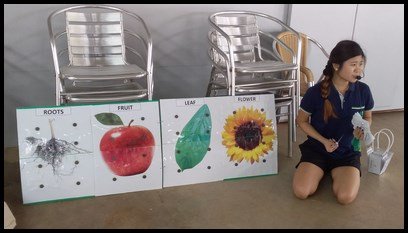The Little House (Montessori)

Ms. Fiona welcomed everyone to the farm and introduced the team of guides that would be assisting the school with the tour.
The children saw the pepper plant. They learnt that it takes a few years for the pepper plant to grow and it only requires rain water to grow. It grows by step cutting.
The children were given the opportunity to smell the pepper plant.
Ms. Fiona explained more about the pineapple plant. The children learnt that it takes approximately 8 months for the plant to grow. Ms. Fiona shared that one can eat the fruit and let the plant grow again.
The children were then led to the showcase greenhouse.
The children stood in front of the young lettuce. The holes are spread apart to allow the plants to grow without needing to fight for sunlight.
Everyone helped by placing the young lettuce into their respective "new homes" until it grows big enough to be moved again.
They were shown the pumps that help to provide water to the plants.
They were shown a brown powder called Cocopeat that resembled soil. Cocopeat is made of coconut husks.
The adult butterhead lettuce are placed in a pool with cold water.
The lettuce requires a lot of water to grow well. The roots for the adult lettuce are much longer than the young lettuce.
The pulley system helps the farmers to pull the plants towards or away from them. They are able to organise the plants according to its growth.
Green Corals.
Red Oaks.
The children were taken to the nursery where the plants are watered with a sprinkler system.
These are about 8 days old.
The tap was turned on and the children were asked to try and identify where the water was coming from.
While trying to look for the sprinklers, some found a tiny frog on the ground.
The children were thrilled to feel the water on them and they also pointed out where the water was coming from.
The red knobs are called red overhead springlets.
While touring the nursery, the children were curious to know what the yellow sheets were.
This sticky yellow sheet is used to catch flies. The flies see the yellow paper as green and when they come to it thinking it is a plant, they get stuck on it.
The children got the opportunity to view the yellow paper closely, but were asked not to touch it. The sticky substance will stick to the skin and it can be removed with oil.
Ms Fiona plucked some mint leaves for the children to smell.
The thorns of the aloe vera are removed with a peeler. The peeler is also used to remove the skin.
The aloe vera after it is peeled. It has to be washed thoroughly after getting peeled as the yellow sap is mildly poisonous and can cause the skin to itch.
Ms. Fiona explained that in order to plant the tree, you need to cut the stem, pluck the sides of the leaves and put it in water.
Feeling the aloe vera.
The children were shown aloe vera plants which were around 3 to 4 years old. The children learnt that the aloe vera plant has thorns to protect itself from animals that eat it.
Ms. Fiona told the children to dry their hands by rubbing their palms together and flapping their arms.
They were given placards with various fruits and vegetables and were asked to categorise them based on their colours.
The children were shown a squash, cucumber, turnip and pumpkin.
They passed these around.
The children were also taught about roots, fruits, leaves and flowers of different plants.
They were given placards and were tasked to categorise them into the different groups.
Butterhead, green coral, red oak and cherry tomatoes were used to make the salad.
Green coral.
Red oak.
The children took turns to pluck the leaves of lettuce and placed it in the bowl.
The dressing for the salad was apple cider vinegar.
Salads were then packed into containers for the children to take home.



















































